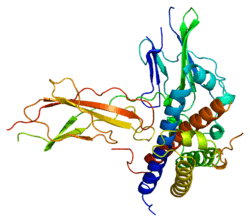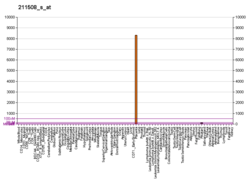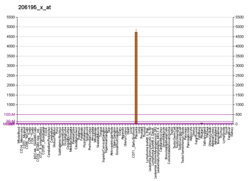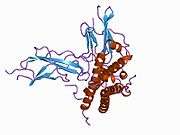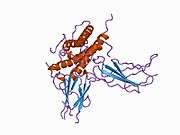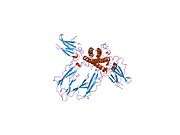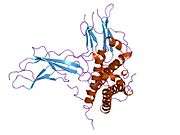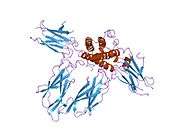Growth hormone 2
Growth hormone 2 (GH2), also known more commonly as placental growth hormone (PGH) or as growth hormone variant (GH-V), is a protein that in humans is encoded by the GH2 gene.[3][4] It is produced by and secreted from the placenta during pregnancy, and becomes the predominant form of growth hormone (GH) in the body during this time.[5][6] Its cogener is growth hormone 1 (GH1), or pituitary growth hormone.
The protein encoded by this gene is a member of the somatotropin/prolactin family of hormones, playing an important role in growth control. The gene, along with four other related genes, is located at the growth hormone locus on chromosome 17 where they are interspersed in the same transcriptional orientation; an arrangement which is thought to have evolved by a series of gene duplications. The five genes share a remarkably high degree of sequence identity. Alternative splicing generates additional isoforms of each of the five growth hormones, leading to further diversity and potential for specialization. As in the case of its pituitary counterpart, growth hormone 1, the predominant isoform of this particular family member shows similar somatogenic activity, with reduced lactogenic activity. Mutations in this gene lead to placental growth hormone/lactogen deficiency.[4]
See also
References
- 1 2 3 GRCh38: Ensembl release 89: ENSG00000136487 - Ensembl, May 2017
- ↑ "Human PubMed Reference:".
- ↑ Barsh GS, Seeburg PH, Gelinas RE (Aug 1983). "The human growth hormone gene family: structure and evolution of the chromosomal locus". Nucleic Acids Res. 11 (12): 3939–58. doi:10.1093/nar/11.12.3939. PMC 326017. PMID 6306568.
- 1 2 "Entrez Gene: GH2 growth hormone 2".
- ↑ Handwerger S, Freemark M (2000). "The roles of placental growth hormone and placental lactogen in the regulation of human fetal growth and development". J. Pediatr. Endocrinol. Metab. 13 (4): 343–56. doi:10.1515/jpem.2000.13.4.343. PMID 10776988.
- ↑ Lacroix MC, Guibourdenche J, Frendo JL, Muller F, Evain-Brion D (2002). "Human placental growth hormone--a review". Placenta. 23 Suppl A: S87–94. doi:10.1053/plac.2002.0811. PMID 11978064.
Further reading
- MacLeod JN, Lee AK, Liebhaber SA, Cooke NE (1992). "Developmental control and alternative splicing of the placentally expressed transcripts from the human growth hormone gene cluster". J. Biol. Chem. 267 (20): 14219–26. PMID 1378436.
- Baumann G, Dávila N, Shaw MA, et al. (1992). "Binding of human growth hormone (GH)-variant (placental GH) to GH-binding proteins in human plasma". J. Clin. Endocrinol. Metab. 73 (6): 1175–9. doi:10.1210/jcem-73-6-1175. PMID 1955498.
- Vnencak-Jones CL, Phillips JA (1991). "Hot spots for growth hormone gene deletions in homologous regions outside of Alu repeats". Science. 250 (4988): 1745–8. doi:10.1126/science.1980158. PMID 1980158.
- Frankenne F, Scippo ML, Van Beeumen J, et al. (1990). "Identification of placental human growth hormone as the growth hormone-V gene expression product". J. Clin. Endocrinol. Metab. 71 (1): 15–8. doi:10.1210/jcem-71-1-15. PMID 2196278.
- Igout A, Scippo ML, Frankenne F, Hennen G (1988). "Cloning and nucleotide sequence of placental hGH-V cDNA". Arch. Int. Physiol. Biochim. 96 (1): 63–7. doi:10.3109/13813458809079626. PMID 2460050.
- Chen EY, Liao YC, Smith DH, et al. (1989). "The human growth hormone locus: nucleotide sequence, biology, and evolution". Genomics. 4 (4): 479–97. doi:10.1016/0888-7543(89)90271-1. PMID 2744760.
- Cooke NE, Ray J, Emery JG, Liebhaber SA (1988). "Two distinct species of human growth hormone-variant mRNA in the human placenta predict the expression of novel growth hormone proteins". J. Biol. Chem. 263 (18): 9001–6. PMID 3379057.
- George DL, Phillips JA, Francke U, Seeburg PH (1981). "The genes for growth hormone and chorionic somatomammotropin are on the long arm of human chromosome 17 in region q21 to qter". Hum. Genet. 57 (2): 138–41. doi:10.1007/BF00282009. PMID 6262212.
- Kidd VJ, Saunders GF (1982). "Linkage arrangement of human placental lactogen and growth hormone genes". J. Biol. Chem. 257 (18): 10673–80. PMID 6286668.
- Harper ME, Barrera-Saldaña HA, Saunders GF (1982). "Chromosomal localization of the human placental lactogen-growth hormone gene cluster to 17q22-24". Am. J. Hum. Genet. 34 (2): 227–34. PMC 1685277. PMID 7072716.
- Seeburg PH (1983). "The human growth hormone gene family: nucleotide sequences show recent divergence and predict a new polypeptide hormone". DNA. 1 (3): 239–49. doi:10.1089/dna.1.1982.1.239. PMID 7169009.
- Owerbach D, Rutter WJ, Martial JA, et al. (1980). "Genes for growth hormone, chorionic somatommammotropin, and growth hormones-like gene on chromosome 17 in humans". Science. 209 (4453): 289–92. doi:10.1126/science.7384802. PMID 7384802.
- Sundström M, Lundqvist T, Rödin J, et al. (1997). "Crystal structure of an antagonist mutant of human growth hormone, G120R, in complex with its receptor at 2.9 A resolution". J. Biol. Chem. 271 (50): 32197–203. doi:10.1074/jbc.271.50.32197. PMID 8943276.
- Melen L, Hennen G, Dullaart RP, et al. (1997). "Both pituitary and placental growth hormone transcripts are expressed in human peripheral blood mononuclear cells (PBMC)". Clin. Exp. Immunol. 110 (2): 336–40. doi:10.1111/j.1365-2249.1997.tb08337.x. PMC 2265512. PMID 9367422.
- Boguszewski CL, Svensson PA, Jansson T, et al. (1998). "Cloning of two novel growth hormone transcripts expressed in human placenta". J. Clin. Endocrinol. Metab. 83 (8): 2878–85. doi:10.1210/jc.83.8.2878. PMID 9709963.
- Untergasser G, Hermann M, Rumpold H, Berger P (1998). "Complex alternative splicing of the GH-V gene in the human testis". Eur. J. Endocrinol. 139 (4): 424–7. doi:10.1530/eje.0.1390424. PMID 9820620.
- Graichen R, Liu D, Sun Y, et al. (2002). "Autocrine human growth hormone inhibits placental transforming growth factor-beta gene transcription to prevent apoptosis and allow cell cycle progression of human mammary carcinoma cells". J. Biol. Chem. 277 (29): 26662–72. doi:10.1074/jbc.M109931200. PMID 11994274.
- Silva CM, Kloth MT, Lyons CE, et al. (2003). "Intracellular signaling by growth hormone variant (GH-V)". Growth Horm. IGF Res. 12 (5): 374–80. doi:10.1016/S1096-6374(02)00048-5. PMID 12213191.
- Strausberg RL, Feingold EA, Grouse LH, et al. (2003). "Generation and initial analysis of more than 15,000 full-length human and mouse cDNA sequences". Proc. Natl. Acad. Sci. U.S.A. 99 (26): 16899–903. doi:10.1073/pnas.242603899. PMC 139241. PMID 12477932.
